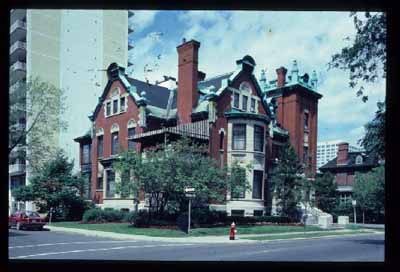John R. Booth Residence National Historic Site of Canada
Ottawa, Ontario

General view
© Parks Canada Agency/ Agence Parcs Canada, 1982.
Address :
252 Metcalfe Street, Ottawa, Ontario
Recognition Statute:
Historic Sites and Monuments Act (R.S.C., 1985, c. H-4)
Designation Date:
1990-11-16
Dates:
-
1909 to 1909
(Construction)
Event, Person, Organization:
-
John R. Booth
(Person)
-
John W.H.Watts
(Architect)
Other Name(s):
-
John R. Booth Residence
(Designation Name)
-
Laurentian Club
(Other Name)
-
Laurentian Leadership Centre
(Other Name)
Plaque(s)
Existing plaque: 252 Metcalfe Street, Ottawa, Ontario
This refined and elegant Queen Anne Revival house is as impressive now as when it was built in 1909 for lumber baron John R. Booth. Hallmark features of this style, popular from the 1880s to the 1910s, are displayed in the two main façades of the house. Stylistic elements inspired by late medieval sources include the elaborate shaped gables, ornate stone moulding and the roof's intersecting ridges. Architect John W. H. Watts enhanced the design by adding a square corner tower surmounted by finely sculpted finials to create a house of baronial grandeur.
Description of Historic Place
The John R. Booth Residence National Historic Site of Canada is located in Ottawa, Ontario. This large house, built in 1909, is a sophisticated composition in the Queen Anne Revival style. Its design features multiple projections, elaborately shaped gables, ornate stone moulding and a medieval style square corner tower. The house interior retains many original features and finishes. The effect of these combined elements is one of opulent grandeur. Official recognition refers to the building on its legal lot as defined at the time of its designation.
Heritage Value
The John R. Booth Residence was designated a national historic site of Canada in 1990 because: it is a nationally significant example of the Queen Anne Revival style as expressed in domestic architecture.
This luxurious house was constructed in 1909 for prominent lumber baron John R. Booth. A fine example of the Queen Anne Revival style, its corner lot allows both principal façades to be appreciated independently. When viewed from an angle, balance and harmony is conveyed through the gables of similar design anchored by a tall chimney at the point of intersection. John R. Booth died in 1925 and the house remained in the Booth family until 1947 when it was sold to the Laurentian Club of Ottawa. Trinity Western University acquired the site in 2001 to establish a base for educational programs in Ottawa and subsequently opened the Laurentian Leadership Centre in 2002.
Source: Historic Sites and Monuments Board of Canada, Minutes, September 1990.
Character-Defining Elements
Key elements that contribute to the heritage character of the site include: the prominent location on a corner lot; the asymmetrical massing, set under a lively roofline with intersecting ridges, shaped gables, dormers and a tall, ribbed chimney stack; the variety of projecting features including the square tower, bay windows, porches, wings, sunrooms and verandahs; the construction of red brick with contrasting stone trim; the eclectic use of stylistic features such as the classically inspired Venetian windows, and medieval features including a square tower with finely sculpted finials; the various window types, including Venetian and bay under a classically shaped pediment, their original placement and materials; the remaining original interior decoration, including the rich variety of wood finishes including panelling, overmantles, and a fine, sculpted staircase; surviving evidence of the original functional layout; the carved stone entrance; its setting on a landscaped lot.